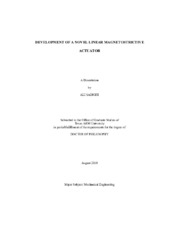| dc.contributor.advisor | Kim, Won-jong | |
| dc.creator | Sadighi, Ali | |
| dc.date.accessioned | 2010-10-12T22:31:43Z | |
| dc.date.accessioned | 2010-10-14T16:07:12Z | |
| dc.date.available | 2010-10-12T22:31:43Z | |
| dc.date.available | 2010-10-14T16:07:12Z | |
| dc.date.created | 2010-08 | |
| dc.date.issued | 2010-10-12 | |
| dc.date.submitted | August 2010 | |
| dc.identifier.uri | https://hdl.handle.net/1969.1/ETD-TAMU-2010-08-7953 | |
| dc.description.abstract | This dissertation presents the development of a novel linear magnetostrictive actuator. The magnetostrictive material used here is Terfenol-D, an alloy of the formula Tb0.3Dy0.7Fe1.92. In response to a traveling magnetic field inside the Terfenol-D element, it moves in the opposite direction with a peristaltic motion. The proposed design offers the flexibility to operate the actuator in various configurations including local and conventional three-phase excitation.
The conceptual design of the linear magnetostrictive actuator was performed during which different configurations were analyzed. Finite Element Analysis (FEA) was extensively used for magnetic circuit design and analysis in conceptual design. Eventually one of these designs was chosen based on which detailed design of linear magnetostrictive actuator was carried out. A new force transmission assembly incorporates spring washers to avoid the wear due to the sudden collision of Terfenol-D element with the force transmission assembly. All mechanical parts were then fabricated at the mechanical engineering machine shop.
The power electronics to operate the motor in a local three-phase mode was designed and implemented. It was demonstrated that the power consumption can be reduced significantly by operating the magnetostrictive linear actuator in the local excitation mode.
A finite-element model of the actuator was developed using ATILA and an empirical model was presented using the data gathered from numerous tests performed on the actuator. The closed-loop control system was implemented using relay control which resulted in an optimal closed-loop performance. The magnetostrictive actuator has demonstrated 410-N load capacity with a travel range of 45 mm, and the maximum speed is 9 mm/min. The maximum power consumption by the motor is 95 W.
The sensorless control of the linear magnetostrictive actuator was successfully conducted using two different approaches. First, using a linear-approximation method, we achieved a position estimation capability with ±1 mm error. Then, an adaptive neuro-fuzzy inference system was employed for estimating the position which resulted in a position estimation capability with only a ±0.5 mm error. | en |
| dc.format.mimetype | application/pdf | |
| dc.language.iso | en_US | |
| dc.subject | Actuators | en |
| dc.subject | Linear Motor | en |
| dc.subject | Magnetostriction | en |
| dc.subject | Relay Control System | en |
| dc.subject | Sensorless Control | en |
| dc.subject | Neural Networks | en |
| dc.title | Development of a Novel Linear Magnetostrictive Actuator | en |
| dc.type | Book | en |
| dc.type | Thesis | en |
| thesis.degree.department | Mechanical Engineering | en |
| thesis.degree.discipline | Mechanical Engineering | en |
| thesis.degree.grantor | Texas A&M University | en |
| thesis.degree.name | Doctor of Philosophy | en |
| thesis.degree.level | Doctoral | en |
| dc.contributor.committeeMember | Langari, Reza | |
| dc.contributor.committeeMember | Toliyat, Hamid A. | |
| dc.contributor.committeeMember | McAdams, Daniel A. | |
| dc.type.genre | Electronic Dissertation | en |
| dc.type.material | text | en |


